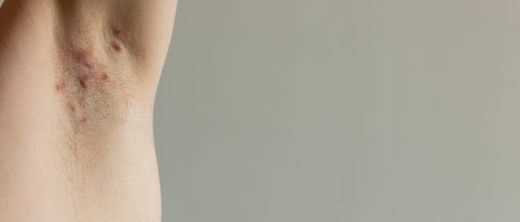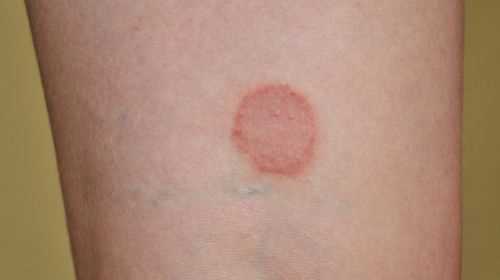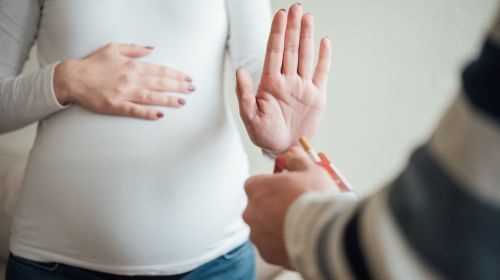Acne inversa is a disease in which there is massive inflammatory skin changes. The armpits and the genital area are particularly affected, preferably the perineum and groin. What are the causes, which treatment really helps, and what are the risk factors.
Acne inversa (hidradenitis suppurativa) is a chronic autoimmune disease that causes inflammation of the skin with severe pus formation. The foci of inflammation are often mistaken for pimples or abscesses. For those affected, this often means a long journey of suffering until diagnosis, which is associated with severe pain and feelings of shame. The earlier acne inversa is recognized, the better it can be treated. In Germany, an estimated 830,000 people are affected by acne inversa, women more often than men.
At a glance:
Causes of acne inversa
Today we know that acne inversa is based on a defect in the innate immune system. The disease is inherited and occurs in families. The skin of those affected has significantly fewer antibodies than that of healthy people. There are also some risk factors that favor the disease:
The development of acne inversa has nothing to do with poor hygiene, as is sometimes wrongly assumed. Those affected are often affected by rheumatic diseases, diabetes and disorders of the lipid metabolism, women also from the polycystic ovary syndrome and insulin resistance.
Psychological stress and hormonal changes can also have a negative impact on the course of acne inversa. The disease usually occurs for the first time from the age of 20.
Symptoms of acne inversa
Acne inversa shows up on the skin with symptoms such as large lumps that congregate in beaded strands. When pressure is applied to the affected areas of the skin, a foul-smelling secretion from sebum and pus can evacuate. Those affected complain of severe pain. Over time, scars form on the previously inflamed areas. Under the skin there is a duct system with many inflammatory fistulas (tube-like connection between the skin and a cavity), which is why many inflamed areas often appear in different places one after the other.
Acne inversa is divided into three stages:
Stage 1: Individual abscesses, no fistulas
Stage 2: One or more widely spaced abscesses with fistulas and scarring
Stage 3: Extensive, extensive involvement with abscesses, fistulas and scarring
Certain movements such as walking and stretching can be very painful for acne inversa. If the symptoms affect the buttocks / anus, perineum and gluteal folds, the sufferer has particularly uncomfortable pain when sitting. Fever is rare.
In severe cases, those affected often withdraw from other people because they are very ashamed of the noticeable and sometimes foul-smelling skin changes. The psychological impairment in severe acne inversa is therefore very high. Since the genital area is often affected, this usually also has an impact on sex life.
Long road to diagnosis
In the case of acne inversa, it can sometimes take a while to be correctly diagnosed, as it can look very different and can easily be confused with other skin diseases – for example, recurrent sweat gland abscesses or coccyx fistulas.
In addition to the mere skin examination, a detailed discussion about the course of the disease and the accompanying circumstances is important. Information on smoking habits, previous illnesses and other cases of acne inversa in the family will help make the correct diagnosis easier.
The skin changes are examined by a doctor and carefully felt. A blood test is usually only necessary if the inflammation has spread very far.
With an ultrasound examination (sonography) or a magnetic resonance tomography (MRT) – often with contrast medium – it can be checked how far the fistula ducts have already expanded.
If the inflammation occurs on the buttocks in the perianal area (around the anus), other diseases such as Crohn’s disease must be ruled out.
Treatment: what helps with acne inversa?
The therapy of acne inversa depends on the severity of the disease. If there are only isolated lumps without deep fistulas and scars, antibiotic ointments (e.g. with clindamycin) can be helpful, sometimes in combination with peelings that dissolve the horn (e.g. with resorcinol).
Some people with acne inversa respond well to oral antibiotic therapy (such as clindamycin and rifampicin). In women, hormonal antiandrogenic therapy such as the pill can help to get skin problems under control. In general, however, acne inversa does not respond as well to this treatment as other forms of acne.
In the case of advanced acne inversa (3rd stage), the only effective treatment is usually a large-scale operation. A scalpel or laser is used to remove the entire inflamed area, including a safety margin, in order to remove all subterranean sources of inflammation. If diseased tissue remains on the body, it almost always relapses. The “holes” in the skin caused by the operation are either closed with skin from the immediate vicinity or the wound heals openly. Then slowly, from the inside out, a scar forms.
Course: complications of acne inversa
In the course of acne inversa, various other complications are possible:
- Erysipelas (inflammation of the skin caused by certain bacteria, so-called streptococci)
- Phlegmon (comprehensive, aggressive tissue inflammation)
- Lymphedema (swelling caused by accumulated lymph fluid, often in the genital area)
- Sepsis (“blood poisoning”)
If the inflammation remains untreated for years, a certain type of skin cancer (squamous cell carcinoma) can develop on the affected cells, albeit very rarely. Finally, the fistulas on the buttocks can also spread to the rectum and ureter. It is all the more important to seek medical advice at an early stage in the case of acne inversa in order to prevent a severe course.
Prevent acne inversa
Acne inversa can be prevented quite well, even if there is a genetic predisposition to the disease. Today we know that various factors have a decisive influence on the disease.
The following tips can largely prevent acne inversa:
Reduce nicotine consumption as much as possible or stop smoking altogether.
Lose excess weight with a balanced diet and regular exercise.
Avoid tight-fitting and abrasive clothing.
If there is a tendency to skin inflammation, nodules and ingrown hairs, do not shave the relevant areas wet or only shave gently (in one go with the line).
Use a mild deodorant under the armpits that does not unnecessarily irritate the skin.
These tips not only prevent acne inversa, but can also have a positive effect on the course of an existing skin disease. Above all, experts recommend quitting smoking at any stage of acne inversa.
.


